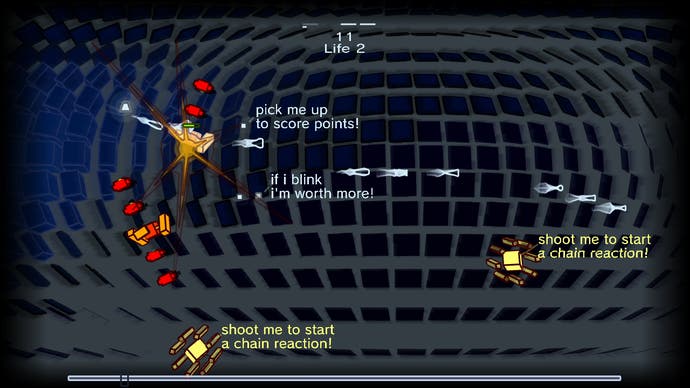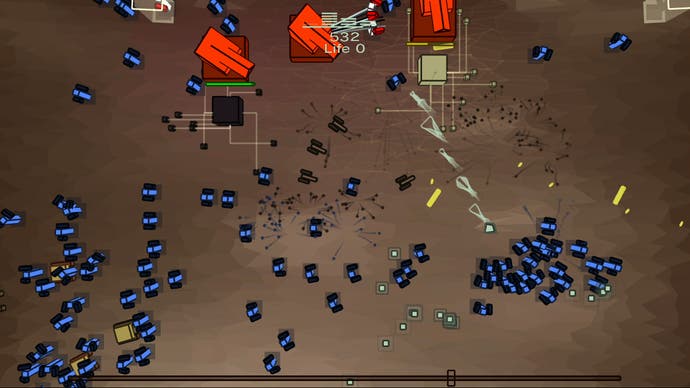Riff: Everyday Shooter
Unless she behaves.
Despite his protestations in an encouraging "Notes" section that rails against "games-are-art-theory-wankery", I have a feeling that Riff: Everyday Shooter author Jonathan Mak will struggle to escape veneration by the aesthetes of my profession - what with having cited Kenta Cho, Kanta Matsuhisa and Tetsuya Mizuguchi as direct influences, and having then turned in an album of musical shoot-'em-up levels that derive their mechanics from the principle that "even the simplest thing can be the most beautiful thing". Whether or not you get lost in the elegance and subtle meticulousness of his compositions, though (and we will be doing that presently, by the way), you'll still be pleased with what's on offer here: eight distinctive examples of the two-stick shooter that start off well and only get better the more you play them.
Beyond a simple menu system and a few guitar twangs set against a pretty visualisation, the first level makes clear the rules: you direct a very small object - let's call it a spaceship - with the left stick and fire a stream of bullets with the right, and the object is to take out the various enemies floating purposefully around the screen and then collect the little pixels that they leave behind.

Each level alters graphics, enemy behaviour and appearance patterns considerably, and ambles along for the duration of a particular piece of music, which reacts playfully to successful attacks. Individual levels also feature their own combo systems. The first has spinning golden stars that float away from the point of your bullet's contact to form wiggling funnels of light that can be inflated and sustained by repeated fire and initiate chains of explosion in any adjacent enemies when they envelope them. Another pegs the screen with bacterial splatters networked by lines, which require sustained fire to dispatch and allow you to eradicate several at once by picking a well-networked target. Uncovering the secrets to each level's more impressive chain reactions requires repeated exposure and experimentation - although simply knowing what's likely to happen won't guarantee success - and survival itself is a healthy challenge for your thumbs as your more persistent adversaries dog your heels and often move faster than you can while you're firing.
Being able to move more quickly when you're not firing is a smart twist with intuitive strategic consequences, but there are much smarter decisions at the heart of Everyday Shooter's logic. Something I noticed quite early on was that ship movement on the left stick is perfectly analogue, but that firing is not. Rather like Geometry Wars: Galaxies on the DS, your lines of fire map to a d-pad's eight directions with gentle adjustments that mask the effect. Far from a limitation or an oversight, this allows you to strafe targets with larger health bars more effectively, and in the tight corners of busier levels it gives you a better chance of navigating clusters of one-hit enemies.

Rather than finishing a level to unlock the next and then being able to pick up where you left off, Everyday Shooter also deposits you at the start of the album each time you run out of lives. Old school in theory, it's decidedly new school in approach, issuing additional "Unlock Points" for every dropped pixel you collect - whether or not you exceed your highest score on that particular play-through - and these can be invested in additional starting lives, as well as natty visual effects to brighten up the levels, and "Single Play" unlockables that allow you to practice individual levels away from the main eight-in-a-row single-player gameplay mode. Like some of Q Entertainment's better shooters, difficulty isn't on a purely upward trajectory, either, alternating somewhat between more frenzied levels, which require you to have your wits about you for every twist of the stick, and less aggressively appointed tasks that give you room to breathe between onslaughts. Mak's musical decisions are carefully tuned to the gameplay conditions, too, capturing the tone and pace of each composition to the point that you're not sure which came first: the music or the monsters.
There are certainly moments of frustration to endure - enemies that can seem to spawn beneath you, graphics that sometimes layer themselves counter-intuitively so that it's difficult to place yourself in the maelstrom, and a significant challenge that may prove too substantial for less practised stick-twiddlers - but the preceding paragraphs should help you divine whether or not this will suit you. I hope it does. It's another example of Sony plugging resources into talented developers whose work doesn't necessarily belong in a snazzy case on the pages of Amazon or on the shelves of GAME. At GBP 4.99, it sits comfortably alongside PSN's best games, like Super Stardust HD, bothering your wallet no more than a beer and a video. To go back to Jonathan Mak's release notes, he says that he hopes it will inspire others so that he can repay the debt he feels to the likes of Cho and Mizuguchi. I only hope the receipts inspire him to continue down this path, because I know I'll be waiting with funds in my PSN wallet.

